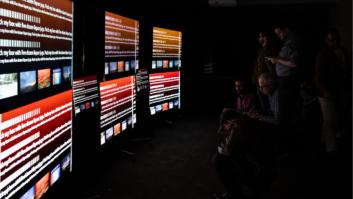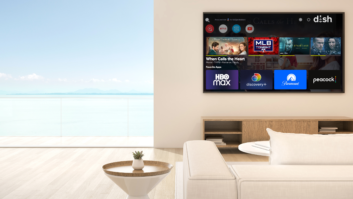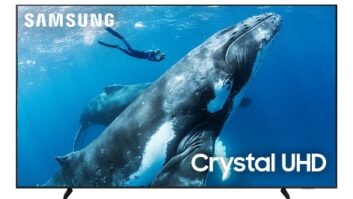
When I started off as an installer, new clients would frequently ask my opinion on whether I thought they should go with cable or satellite. (Over-the-air antenna is not really an option in our area. Unless you really like watching all ETV all the time, in which case, brother, we’ve got you covered!) My pat response was that our systems were technology agnostic; they would work fine with either one, and it was really just a matter of personal preference.
Of course, nearly every customer ended up going the cable route because it was just easier. You didn’t need a set-top box at each TV; just plug in your cable and you’re good to go. You also could spare yourself from the potential stigma of being ostracized by your neighbors and homeowner’s association by having a satellite dish on or near your home.
But now that I’ve been on this merry-go-round for a while, and I’ve had a chance to live with DISH’s Hopper and Joey system at my own home for a couple of years, I’ve changed my tune. Now when people ask me this question, I’m no longer neutral and I strongly recommend they go with satellite. Here’s why:
Service Calls
The number-one phone troubleshooting call that I receive without a doubt is cable box related.
“I’m not getting a picture on that TV you sold me.”
“There’s no sound on that system you sold me.”
“That remote you sold me isn’t working my TV anymore.”
“I’m not getting all the channels on my TV.”
In the customer’s eyes, the “TV” and all things related to it are our problem. They can’t separate the actual TV from the cable box attached to it. So when the TV has a black/grey/blue screen of death, they call us, because, undoubtedly, “that TV we sold them” must be broken. In reality, all of these things are typically cable box related, and are usually resolved by rebooting—or in many cases, replacing—the box. But depending on the client, asking them to reboot their cable box by unplugging the power cable could be akin to suggesting they do a little impromptu open-heart surgery on a neighbor. In the two years that I’ve had my Hopper, I’ve had to reboot it less than five times. And when I do need to reboot it, there is an easy-to-access, red “RESET” button right on the front panel. Also, I don’t think that I’ve ever had to give any phone tech support that is satellite related.
Discrete Power
If Scientific Atlanta, Motorola, and Samsung would add discrete power commands to their IR library, it just might go a long way toward healing some of the wounds and deep-seated hatred I feel about them. I mean, why NOT give a discrete power command? It’s not like it would add one infinitesimal cent to the cost of manufacturing. For a while, SA gave us a “power on numeric” that we used as a workaround, but a firmware update took that feature away. I guess we installers were abusing it by actually using it or something. (And, by the way, them taking this away was really extra-special sweet because it meant we had to go around and reprogram a bunch of remotes that were now no longer turning the boxes on and off correctly. So bully for that!) As it is, you have to just issue a power command and blindly hope you aren’t turning the box off. Or leave it on all the time and play a game of cable company Russian roulette as you wait for them to randomly reboot the box at some point. With DISH, I get my discrete commands and never worry about getting out of sync. And if I somehow DID get out of sync, I get a nice graphic on the TV which says, “Press Select to watch” instead of a screen of death.
Picture Quality
I had been somewhat skeptical that satellite actually looked better right up to the second where I turned the Hopper on my Elite Plasma for the very first time. Instantly the picture was just…better. It’s cleaner, with no noise, or macro blocking or banding or motion artifacts or any of the other yucky stuff you get from cable and their extra levels of heavy-handed secret sauce compression. While most people will probably never notice the better picture, some of your clients will. And even if they don’t notice it right away, you’ll be saving yourself from the down-the-road calls when they do notice the blocking and other digital artifacts that they will notice from cable.
Support
I am almost tempted to say that I’ll give a dollar to anyone that has ever heard the comment, “Man! I just LOVE dealing with the cable company! Those guys are awesome and never make me wait on hold or sit around for an 8 hour service call window!” The truth is, the only experience that might rival dealing with the cable company is a thorough IRS audit or full day love-in at the DMV. Conversely, every time I’ve had to contact DISH it has been a pleasure. They call multiple times before the service appointment to confirm their arrival and tweak the visit to accommodate my schedule. When they come they have all been super professional and knowledgeable. They have even performed service calls on Sunday. In fact, I’ve wanted to hire every one of the installers that have come out to my house.
System Quality
On the surface, a cable box doesn’t look inherently evil. I mean, they resemble most other bits of technology and have the outputs we’re familiar with. But each box seems uniquely hell bent on locking up whenever the most important viewing event in people’s lives is about to happen. And based on the reliability of the boxes, I’m guessing that they have been built from the cheapest parts available, in the sweatiest of sweatshops, in the worst part of town, in the thirdest of world countries in a factory built on cursed ground. I’m also highly suspicious that whenever someone brings a broken box back to the cable company and requests a new one that the agent just takes the old, broken box and puts it back on the shelf to hand to the next person.
In contrast the DISH system has a super-fast Broadcom BCM7425 processor and way larger, more durable 2 Terabyte hard drive and built in 802.11n WiFi. This makes for much faster performance, the ability to store up to 2,000 hours of recordings, and an easy way to connect to any home’s network. Plus DISH offers things that would fry the poor little cable box’s simple CPU. Things like a way slicker user interface and searching features to track down your favorite shows. Or Super Joey where you can record up to 8 programs at once (with PrimeTime Anytime enabled). Or Hopper with Sling lets you transfer programs to an iPad to watch anywhere you don’t have internet access. Or apps like Pandora, Facebook, Twitter, and Game Finder to track your favorite sports and teams. From a hardware standpoint, DISH owns anything the cable company will ever put out.
Wireless and Virtual Joeys
The issue with satellite has always been the need to have a local set-top-box at each TV. For some people this is just unacceptable. They hold some irrational hatred for another box and when you say, “You’ll need to have a box for this TV,” they hear, “I’m going to just leave a massive lump of poison right here, cool?” Beyond people’s feelings about the box, adding a receiver on some installs just isn’t possible; say if you can’t get a wire to a TV or if there is no room to place a box. (Though, I’ll admit that the Joey is so small I have it wall-mounted behind the flat panel TV in my bedroom. Along with a Control4 HC250 processor. And a Kaleidescape M300 movie player. There’s more tech secreted behind that flat panel TV than in many people’s entire systems.)
At this year’s CES, DISH launched two new products to address both of these issues. With the Wireless Joey, you can now add satellite to any TV, even if there is no existing cabling to the DISH. Even cooler is the new Virtual Joey, which completely eliminates the need for any STB. With a device that supports Virtual Joey—currently limited to LG Smart TVs, and Sony PS3 and PS4—a customer can enjoy the full Hopper experience without needing that dreaded STB.
Money
How much money do you make when a customer signs up for cable? How much do you make when they pay their monthly bill? Or upgrade to additional boxes? Nothing? You do all that extra work helping and supporting the cable company on their lousy products and services and they repay you by (likely) blaming your gear and then giving you nothing in return? You can become a DISH installer and actually make money on the equipment and the services.
So, less grief, better service, performance, and features for your clients and money in your pocket? Umm, yeah. Sorry, cable, but all of this has caused me to lose my faith in you and become a true believer in satellite.

John Sciacca is principal of Custom Theater and Audio in Myrtle Beach, SC.







